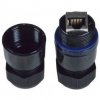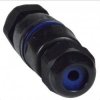I am building my house and I have a 2 direct burial CAT 6 lines buried near my building that got hit with a shovel. One is cut badly and another has the insulation nicked (have not tested it yet), but I presume it is damaged as well. These are long runs that go out to the end of my driveway and I took great care to keep them in one piece with no splices. One shovel swipe by an over paid teenager spoiled those plans. I almost smacked the kid with the shovel myself, I was so steaming mad.
The cut is about 2 feet from the building, so I can repair it with just one splice by pulling slack from the building.
What is the best strategy for splicing these cables underground? I have used underground gel filled splice kits for high voltage cable, but never for data. I''m thinking I should I put connectors on, plug them into a coupler, and seal it up with a gel based splice kit. Am I on the right track? Any advice?
The cut is about 2 feet from the building, so I can repair it with just one splice by pulling slack from the building.
What is the best strategy for splicing these cables underground? I have used underground gel filled splice kits for high voltage cable, but never for data. I''m thinking I should I put connectors on, plug them into a coupler, and seal it up with a gel based splice kit. Am I on the right track? Any advice?


